
Preamble
PhotoACTIVE Equine is the only antimicrobial coating in the world that complies with standard NF EN 14675 (Assessment of the virucidal activity of chemical antiseptics and disinfectants used in the veterinary field), and durable for more than one year on surfaces.
Experimentation in real conditions makes it possible to check that the PhotoACTIVE Equine® technology works as expected, regardless of the surfaces, their cleaning frequency, the degree of dirt brought by healthy or sick animals.
The selection of the Champ du Perier Equine Clinic for the PhotoACTIVE Equine experiment was deliberate. This clinic is renowned for its excellence in equine veterinary care and its commitment to evidence-based medical practices. Its reputation for expertise and rigor in the equestrian field makes it an ideal setting to test the effectiveness and safety of PhotoACTIVE Equine under real and demanding conditions.
By collaborating with an institution of this magnitude, the study aims not only to validate the benefits of PhotoACTIVE Equine but also to contribute to establishing new standards of disinfection in the equestrian environment. The choice of this clinic aligns perfectly with the mission of providing a superior quality disinfection solution, while ensuring that the results of the experiment will be both reliable and relevant for the equestrian sector as a whole.
The Champ du Perier Equine Clinic located in Neyron in Ain department (France) was chosen to carry out this experiment: specialized only in horses, equipped with an operating room, hospitalization boxes and a laboratory, with FEI approved veterinarians traveling to international competitions.
Several of them are present at the Paris Olympic Games 2024.
Equipped Areas
The problem of a clinic is to be able to ensure the microbiological cleanliness of surfaces to avoid the transmission of diseases between individuals as well as postoperative infections (nosocomial diseases).
The difficulty of hygiene in an equine clinic is directly correlated to the large size of the animals: dirt on the walls at the tie, hospitalization and recovery areas of 9 / 12 m² per animal against cages for dogs and cats, large equipment such as restraint bars, surgery table etc… It is also impossible to have a sterile horse in view of an operation: hair, soil cannot be completely cleaned.
Washing and rubbing surfaces with disinfectant is a very tedious and difficult step between each patient. This is why these elements have been selected with the advice of veterinarians:
– walls of examination rooms
– padded recovery room walls, door and floor
– surgery table
– support bars and floors
– walls and door of the quarantine box (picture to the right)
Microbiological readings
Microbiological readings were taken before the PhotoACTIVE Equine coating was applied on 08/12/22 (August 8th, 2022) to obtain average contamination per surface. Then readings are taken periodically to check the effectiveness of the treatment.
The measuring device used is a bioluminometer: the surface is swabbed with a sterile stick, and the device measures the rate of microbiological contamination sampled by analyzing the amount of ATP present.
The unit of measurement is the RLU: Relative Light Unit. The higher this value, the dirtier the surface. For information:
– Less than 150 RLU: clean surface (for medical and agro-food), target value
– Between 151 – 299 RLU: average cleanliness, to be monitored
– Greater than 300 RLU: failure, contaminated surface
| Surface | Photo | Readings before PhotoACTIVE Equine 08/12/22 | Readings after PhotoACTIVE Equine 08/17/22 | Readings after PhotoACTIVE Equine 10/17/22 | Readings after PhotoACTIVE Equine 01/25/23 | Readings after PhotoACTIVE Equine 9/5/23 |
|---|---|---|---|---|---|---|
| Exam Room 1 Walls | 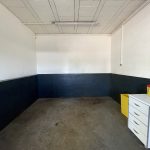 | 1313 | 108 | 143 | 72 | 65 |
| Exam Room 2 Walls | 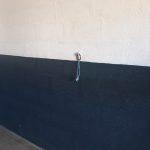 | 306 | 10 | 14 | 34 | 22 |
| Exam Room 3 Front restraint | 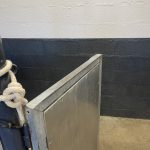 | 628 | 83 | 56 | 65 | 150 |
| Exam Room 3 Rear restraint | 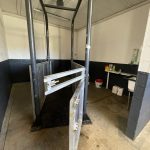 | 307 | 18 | 80 | 87 | 142 |
| Exam Room 4 Front restraint | 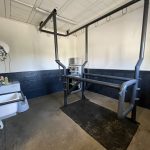 | 565 | 52 | 132 | 62 | 36 |
| Exam Room 4 Rear restraint |  | 870 | 81 | 93 | 74 | 89 |
| Recovery Room Door | 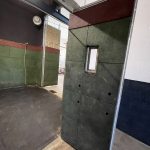 | 5315 | 130 | 120 | 83 | 122 |
| Recovery Room Walls | 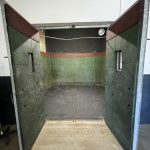 | 5886 | 105 | 27 | 94 | 21 |
| Surgery table Front | 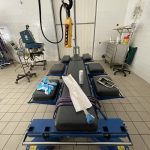 | 324 | 47 | 27 | 36 | 108 |
| Surgery table Rear |  | 382 | 26 | 31 | 22 | 146 |
| Quarantine box Door | 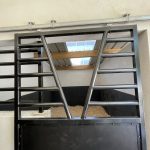 | 542 | 39 | 64 | 101 | 105 |
Interpretation of Results
Measurements Before PhotoACTIVE Equine
The results of the contamination before the installation of the coating (in red) are consistent with the use made of the premises: the surgery table is on average at 350 RLU, i.e. a normal value for a surface disinfected several days ago ( 48 hours without surgery at the time of the test).
Examination room 1 is very often used, and Examination room 2 more rarely, the measurements agree. The slightly grainy painted walls of room 1 reflect a classic contamination on this type of material.
The restraint instruments in Examinations 3 and 4 show concordant contamination rates on the metal: bacteria grow less easily there than on other substrates.
The Quarantine box had not been used for a week at the time of the test.
The Recovery room is the most problematic place in the clinic with values above 5000 RLU: the porous fiber texture to absorb shock also retains fluids and rinsing water. Despite decontamination the day before, the substrate remains highly contaminated.
In conclusion, the place, although properly cleaned and disinfected periodically, shows microbial growth on the surfaces inherent to the passage of animals. The recovery room, on the other hand, is difficult to fully disinfect, and microbial growth there is exponential given the residual humidity of the support.
Here is video of the microbiological survey of the wall in the recovery room with the value of 5886 RLU recorded, on 08/12/22, before the PhotoACTIVE Equine coating was applied.
Measures after PhotoACTIVE Equine from August 2022 to September 2023
Post-coating contamination results show values below 150 RLU, the target value for microbiologically clean surfaces.
The first readings were taken on 08/17/22, i.e. one week after the coating was applied: this measurement makes it possible to verify that PhotoACTIVE Equine has been correctly applied to the identified surfaces.
A second reading was taken on 10/17/22, i.e. two months after the PhotoACTIVE Equine coating was laid: it can be seen that the RLU values read are still low, despite the intensive use of the premises.
The recovery room, despite its porous and flexible surface, shows extremely low rates, only possible thanks to the continuous action of PhotoACTIVE Equine.
A measurement taken in January confirms the effectiveness of the coating 5 months later.
The experiment continued until September 2023, which is one year after the application of the PhotoACTIVE nanocoating. The recorded measurements still meet the expected values, being below 150 RLU. A general trend is emerging with several values ranging between 100 and 150 RLU, indicating that it’s time to reapply the coating.
PhotoACTIVE Equine is the only nanocoating that provides long-term disinfection of surfaces. Its effectiveness has been demonstrated for 1 year at the Clinique du Champ du Perier, a clinic specialized in equine medicine and surgery managed by a team of veterinarians affiliated with the FEI.
Here is video of the microbiological survey of the wall in the recovery room with the value of 21 RLU recorded 1 year after the PhotoACTIVE Equine coating was applied.
Conclusion
PhotoACTIVE Equine is the only nanocoating that disinfects surfaces over a long duration. Its effectiveness was demonstrated over a year at the Clinique du Champ du Perier, a clinic specializing in equine medicine and surgery managed by a team of veterinarians affiliated with the FEI.
ATPmetric tests have revealed a significant decrease in ATP levels on all treated surfaces, thus attesting to its long-term effectiveness in terms of disinfection. This major breakthrough offers a tangible response to the challenges inherent in maintaining a hygienic environment in a veterinary clinic for horses, notably by reducing the workload and associated costs of continuous cleaning and disinfection.
The experiment also demonstrated direct benefits for the health of horses, who were less exposed to diseases and potentially harmful biocides. Recognition by certifications such as NF EN 14675 and ISO standards 14476 and EN 1276 not only confirms the quality of PhotoACTIVE Equine but also its compliance with international health standards.
The results obtained confirm that PhotoACTIVE Equine is not only a revolutionary disinfection solution but also a significant advancement for the health and well-being of horses.
These promising results validate the confidence in the potential of PhotoACTIVE Equine to transform disinfection practices in the equestrian environment, making animal care safer, more effective, and more sustainable.
